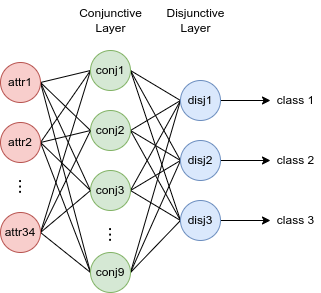This repository contains the source code for multi-label classification experiments in TMC[1] dataset/subsets, accompanied the paper "Neuro-symbolic Rule Learning in Real-world Classification Tasks". Our neural DNF-based models are built upon pix2rule[2]'s semi-symbolic layers.
Check out sibling repo: Neuro-symbolic rule learning with neural DNF-based models in CUB dataset/subsets
Directories
-
conf/: contains hydra config for running experiments. -
scripts/: some useful bash scripts for running data pre-processing and generating FastLAS[3] examples. The scripts rely their corresponding python scripts described below. -
synthetic_test: contains the synthetic multi-label classification tasks, as well as a unit test for our implementation of semi-symbolic layers.
Modules
-
analysis.py: contains variousMeterclasses for different metrics. -
common.py,dataset.py, andutils.py: common reusable classes/functions for experiments. -
dnf_layer.py: implementation of pix2rule's semi-symbolic layer. -
dnf_post_train.py: post-training processes for symbolic rule extraction. -
eval.py: evaluation methods for vanilla neural DNF and ASP rules. -
rule_learner.py: the full vanilla neural DNF model. -
train.py: contains the baseTrainerclass for training a neural DNF-based model.
Python scripts
-
arff_parse.py: arff parsing of TMC dataset. -
data_preprocess.py: data pre-processing script for TMC dataset, also used for generating subsets. The data pre-processing is based on Mutual Information (MI). We calculate the MI of an attribute with respect of the label combination. For the math please refer back to Appendix A.2 in the paper. -
full_pipeline_dnf.py: full pipeline of training a vanilla neural model and post-training processing. -
las_gen.py: script for generating FastLAS learning example and mode biases. -
mlp_baseline.py: full pipeline of training and evaluation of MLP. -
run_post_train.py: post-training process of a vanilla neural DNF model. -
run_train.py: training process of a vanilla neural DNF model.
Our neural DNF-based models are created with pix2rule's semi-symbolic layers.
The vanilla neural DNF model is identical to pix2rule. This is suitable for multi-label classification because of the independence between each target label.
Base python version: >= 3.10
Dataset: TMC2007-500 - download: link
Libraries:
-
Pytorch version >= 1.11.0 - machine learning framework
-
Hydra version >= 1.2 - config management framework
-
Clingo - ASP solver
-
scikit-learn - metrics & decision tree
Optional requirements:
- FastLAS - for symbolic learning from ASP. Our neural DNF-EO model does not require FastLAS.
Data pre-processing
To reproduce our experiments, you will first need to pre-process the data and
create TMC subsets. Go to scripts/ and we have more instructions there.
Vanilla neural DNF model
To run the full training pipeline for vanilla neural DNF model, edit the configs
in conf/ (for more information on how to manage hydra config, refer to their
documentation).
In particular, the important yaml files need to be edited are:
-
conf/model/config.yaml: for changing model architectural design. -
conf/training/dnf_vanilla.yaml: training config for the vanilla neural DNF experiment. -
conf/environment/[name].yaml: paths for the pkl files.
Once you setup the configs, you can run the following command:
python full_pipeline_dnf.py [hydra config overwrites]
MLP
To run the training pipeline for MLP baseline, edit the training configs in the
mlp_baseline.py script, and you still need conf/environment/ set up. Once
ready, run the following command:
python mlp_baseline.py [hydra config overwrites]
[2] Nuri Cingillioglu et al., pix2rule: End-to-end Neuro-symbolic Rule Learning.
